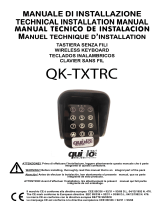
7
UK
6 Notes on connection and extension options
The burglar alarm panel is the basic device of an
electronic security system for protecting your property
(e.g.: apartment, house, garage, shops, etc.). In
combination with other components such as detectors and
signal transmitters, it secures the areas to be monitored.
The alarm is triggered by unauthorised break-in attempts.
The alarm centre is operated by means of the connected
control unit. This enables the alarm centre to be installed
at a hidden location. Up to 4 control units can be
connected. Furthermore, the alarm centre can be
operated via a so-called key switch.
Due to the built-in telephone dialler, the burglar alarm
panel is able to transmit an alarm via the telephone
network to selected subscribers.
The burglar alarm panel has 9 separately evaluated alarm
zones. The alarm centre monitors whether a (minimal)
quiescent current is flowing or not between the two
contacts (CCT) of each alarm zone. If you make a contact
between the alarm zone contacts, this is treated as closed
and a current flow is possible. If no contact exists, no
current flow is possible and the alarm zone is open. Any
changes trigger an alarm, depending on the programming.
Differential monitoring of the alarm zones is also possible
(DEOL).
The alarm centre also has a built-in PC interface.
Properties of the alarm centre:
• 8 freely programmable alarm zones, all of which can be
programmed as follows:
Immediate, delayed, access, panic, 24 hour, fire,
technical or time
• Expandable to a maximum of 32 zones via optional
expansion modules
• 1 tamper zone for connected detectors
• 1 tamper zone for connected signal transmitters
• 1 transistor output and 2 relay outputs that can be
configured for a specific event (alarm, fire, panic,…)
• Integrated transformer (230V AC / 12V DC) for
supplying the alarm centre and connected detectors and
for recharging the battery
• Standby power supply via a 12V/7Ah battery
• Simple programming and operation via 1–4 control units
• The state of the alarm zones and the alarm centre is
displayed on a plain-text display.
• Zone blocking as a way of temporarily removing
individual alarm zones from surveillance
• Access authorisation for operating and programming
using a 4-digit or 6-digit code.
• Tamper contacts for the alarm centre and the control
units
• Alarm and event memory
• Integrated telephone dialler
• Partitioning of the alarm centre for simulation of 4
separate alarm centres




















